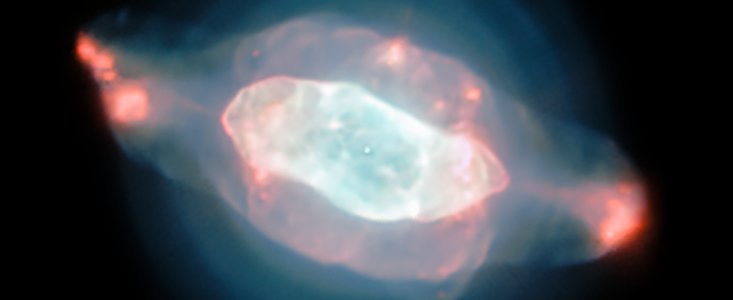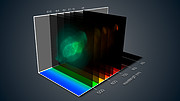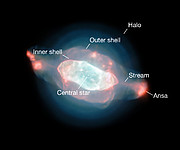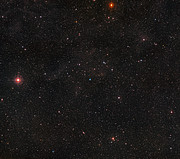Komunikat prasowy
Dziwne struktury w Mgławicy Saturn
27 września 2017
Spektakularna mgławica planetarna NGC 7009, znana jako Mgławica Saturn, wyłania się z ciemności niczym seria baniek mydlanych o dziwnych kształtach rozświetlonych odcieniami różu i błękitu. Kolorowe zdjęcie zostało uzyskane potężnym instrumentem MUSE na teleskopie VLT, który należy do ESO. Wykonano je w ramach badań mających na celu opracowanie po raz pierwszy mapy pyłu wewnątrz mgławicy planetarnej. Mapa, która pokazuje bogactwo zawiłych struktur w pyle, w tym takich jako otoczki, halo, czy dziwne struktury o kształtach fal, pomoże astronomom w zrozumieniu, w jaki sposób mgławice planetarne uzyskują swoje dziwne kształty i symetrie.
Mgławica Saturn jest położona około 5000 lat świetlnych od nas w kierunku gwiazdozbioru Wodnika. Jej nazwa wywodzi się od dziwnego kształtu, który przypomina planetę z pierścieniami, uważaną przez wielu za najpiękniejszą.
Ale w rzeczywistości mgławice planetarne nie mają nic wspólnego z planetami. Mgławica Saturn była kiedyś małomasywną gwiazdą, która pod koniec swojego życia rozdęła się do czerwonego olbrzyma i zaczęła odrzucać swoje zewnętrzne warstwy. Materia ta została wywiana przez silne wiatry gwiazdowe i zenergetyzowana przez promieniowanie ultrafioletowe od pozostałego gorącego jądra, co wytworzyło okołogwiazdową mgławicę pyłu i kolorowego, gorącego gazu. W sercu Mgławicy Saturn znajduje się, widoczna na zdjęciu, skazana na swój los gwiazda, będąca w trakcie procesu stawania się białym karłem [1].
Aby lepiej zrozumieć, w jaki sposób mgławice planetarne są formowane w takie dziwne kształty, międzynarodowy zespół astronomów, którym kierował Jeremy Walsh z ESO, użył instrumentu Multi Unit Spectroscopic Explorer (MUSE), aby zajrzeć z pyłowe zasłony Mgławicy Saturn. MUSE to instrument zainstalowany na jednym z czterech Teleskopów Głównych wchodzących w skład Bardzo Dużego Teleskopu (VLT) w Obserwatorium Paranal w Chile. Jest tak potężny, ponieważ nie tylko tworzy obraz, ale także zbiera informacje o widmie – albo o zakresie barw – światła od obiektu w każdym punkcie obrazu.
Badacze użyli MUSE do utworzenia pierwszych szczegółowych map optycznych gazu i pyłu rozmieszczonego w mgławicy planetarnej [2]. Zdjęcie, które jest jednym z efektów tych prac, pokazuje wiele skomplikowanych struktur, w tym wewnętrzną optyczną otoczkę, zewnętrzną otoczkę i halo. Pokazuje także dwa wcześniej sfotografowane strumienie rozciągające się pomiędzy dwoma krańcami mgławicy wzdłuż długiej osi, kończące się w jasnych „hantlach”.
Co ciekawe, zespół badawczy znalazł także struktury podobne do fal w pyle, który jak dotąd nie zrozumiano w pełni. Pył jest rozmieszczony w całej mgławicy, ale występuje znaczący spadek ilości pyłu na brzegu wewnętrznej otoczki – wydaje się, że jest tam niszczony. Możliwych jest kilka potencjalnych mechanizmów takiej destrukcji. Wewnętrzna otoczka to w zasadzie ekspandująca fala uderzeniowa, zatem być może wbija się w ziarna pyłu, niszcząc je, albo wytwarzając dodatkowy efekt rozgrzewający, co powoduje wyparowanie pyłu.
Wykonanie map gazowych i pyłowych struktur w mgławicach planetarnych pomoże w zrozumieniu ich roli w życiu i śmierci małomasywnych gwiazd, a także będzie pomocne w zrozumieniu przez astronomów, w jaki sposób mgławice planetarne uzyskują swoje dziwne i złożone kształty.
Ale możliwości MUSE wykraczają daleko poza mgławice planetarne. Ten czuły instrument może badać także powstawanie gwiazd i galaktyk we wczesnym Wszechświecie, a także wykonywać mapy rozmieszczenia ciemnej materii w gromadach galaktyk w pobliskiej części Wszechświata. Instrument MUSE wykonał także pierwszą trójwymiarową mapę Filarów Stworzenia w Mgławicy Orzeł (eso1518) i uzyskał obraz widowiskowej kosmicznej kolizji w niedalekiej galaktyce (eso1437).
Uwagi
[1] Mgławice planetarne generalnie żyją krótko, np. Mgławica Saturn będzie istnieć zaledwie przez kilkadziesiąt tysięcy lat, zanim rozproszy się i ochłodzi do takich wartości, że stanie się dla nas niewidzialna. Centralna gwiazda również wtedy osłabnie, bowiem stanie się gorącym białym karłem.
[2] Kosmiczny Teleskop Hubble’a dostarczył wcześniej spektakularnego zdjęcia Mgławicy Saturn — ale, w przeciwieństwie do MUSE, nie pokazał widma w każdym puncie całej mgławicy.
Więcej informacji
ESO jest wiodącą międzyrządową organizacją astronomiczną w Europie i najbardziej produktywnym obserwatorium astronomicznym na świecie. Wspiera je 16 krajów: Austria, Belgia, Brazylia, Czechy, Dania, Finlandia, Francja, Hiszpania, Holandia, Niemcy, Polska, Portugalia, Szwajcaria, Szwecja, Wielka Brytania oraz Włochy. ESO prowadzi ambitne programy dotyczące projektowania, konstrukcji i użytkowania silnych naziemnych instrumentów obserwacyjnych, pozwalając astronomom na dokonywanie znaczących odkryć naukowych. ESO odgrywa wiodącą rolę w promowaniu i organizowaniu współpracy w badaniach astronomicznych. ESO zarządza trzema unikalnymi, światowej klasy obserwatoriami w Chile: La Silla, Paranal i Chajnantor. W Paranal ESO posiada teleskop VLT (Very Large Telescope - Bardzo Duży Teleskop), najbardziej zaawansowane na świecie astronomiczne obserwatorium w świetle widzialnym oraz dwa teleskopy do przeglądów. VISTA pracuje w podczerwieni i jest największym na świecie instrumentem do przeglądów nieba, natomiast VLT Survey Telescope to największy teleskop dedykowany przeglądom nieba wyłącznie w zakresie widzialnym. ESO jest głównym partnerem ALMA, największego istniejącego projektu astronomicznego. Z kolei na Cerro Armazones, niedaleko Paranal, ESO buduje 39-metrowy teleskop ELT (Extremely Large Telescope - Ekstremalnie Wielki Teleskop), który stanie się „największym okiem świata na niebo”.
Linki
- Zdjęcia VLT
- Zdjęcia MUSE
- Komunikat prasowy o pierwszym świetle MUSE
Kontakt
Jeremy Walsh
ESO
Garching bei München, Germany
E-mail: jwalsh@eso.org
Richard Hook
ESO Public Information Officer
Garching bei München, Germany
Tel.: +49 89 3200 6655
Tel. kom.: +49 151 1537 3591
E-mail: rhook@eso.org
Krzysztof Czart (Kontakt dla mediów Polska)
Sieć Popularyzacji Nauki ESO
oraz Urania - Postępy Astronomii
Toruń, Polska
Tel.: +48 513 733 282
E-mail: eson-poland@eso.org
O komunikacie
| Komunikat nr: | eso1731pl |
| Nazwa: | NGC 7009, Saturn Nebula |
| Typ: | Milky Way : Nebula : Type : Planetary |
| Facility: | Very Large Telescope |
| Instrumenty: | MUSE |
Our use of Cookies
We use cookies that are essential for accessing our websites and using our services. We also use cookies to analyse, measure and improve our websites’ performance, to enable content sharing via social media and to display media content hosted on third-party platforms.
ESO Cookies Policy
The European Organisation for Astronomical Research in the Southern Hemisphere (ESO) is the pre-eminent intergovernmental science and technology organisation in astronomy. It carries out an ambitious programme focused on the design, construction and operation of powerful ground-based observing facilities for astronomy.
This Cookies Policy is intended to provide clarity by outlining the cookies used on the ESO public websites, their functions, the options you have for controlling them, and the ways you can contact us for additional details.
What are cookies?
Cookies are small pieces of data stored on your device by websites you visit. They serve various purposes, such as remembering login credentials and preferences and enhance your browsing experience.
Categories of cookies we use
Essential cookies (always active): These cookies are strictly necessary for the proper functioning of our website. Without these cookies, the website cannot operate correctly, and certain services, such as logging in or accessing secure areas, may not be available; because they are essential for the website’s operation, they cannot be disabled.
Functional Cookies: These cookies enhance your browsing experience by enabling additional features and personalization, such as remembering your preferences and settings. While not strictly necessary for the website to function, they improve usability and convenience; these cookies are only placed if you provide your consent.
Analytics cookies: These cookies collect information about how visitors interact with our website, such as which pages are visited most often and how users navigate the site. This data helps us improve website performance, optimize content, and enhance the user experience; these cookies are only placed if you provide your consent. We use the following analytics cookies.
Matomo Cookies:
This website uses Matomo (formerly Piwik), an open source software which enables the statistical analysis of website visits. Matomo uses cookies (text files) which are saved on your computer and which allow us to analyze how you use our website. The website user information generated by the cookies will only be saved on the servers of our IT Department. We use this information to analyze www.eso.org visits and to prepare reports on website activities. These data will not be disclosed to third parties.
On behalf of ESO, Matomo will use this information for the purpose of evaluating your use of the website, compiling reports on website activity and providing other services relating to website activity and internet usage.
Matomo cookies settings:
Additional Third-party cookies on ESO websites: some of our pages display content from external providers, e.g. YouTube.
Such third-party services are outside of ESO control and may, at any time, change their terms of service, use of cookies, etc.
YouTube: Some videos on the ESO website are embedded from ESO’s official YouTube channel. We have enabled YouTube’s privacy-enhanced mode, meaning that no cookies are set unless the user actively clicks on the video to play it. Additionally, in this mode, YouTube does not store any personally identifiable cookie data for embedded video playbacks. For more details, please refer to YouTube’s embedding videos information page.
Cookies can also be classified based on the following elements.
Regarding the domain, there are:
- First-party cookies, set by the website you are currently visiting. They are stored by the same domain that you are browsing and are used to enhance your experience on that site;
- Third-party cookies, set by a domain other than the one you are currently visiting.
As for their duration, cookies can be:
- Browser-session cookies, which are deleted when the user closes the browser;
- Stored cookies, which stay on the user's device for a predetermined period of time.
How to manage cookies
Cookie settings: You can modify your cookie choices for the ESO webpages at any time by clicking on the link Cookie settings at the bottom of any page.
In your browser: If you wish to delete cookies or instruct your browser to delete or block cookies by default, please visit the help pages of your browser:
Please be aware that if you delete or decline cookies, certain functionalities of our website may be not be available and your browsing experience may be affected.
You can set most browsers to prevent any cookies being placed on your device, but you may then have to manually adjust some preferences every time you visit a site/page. And some services and functionalities may not work properly at all (e.g. profile logging-in, shop check out).
Updates to the ESO Cookies Policy
The ESO Cookies Policy may be subject to future updates, which will be made available on this page.
Additional information
For any queries related to cookies, please contact: pdprATesoDOTorg.
As ESO public webpages are managed by our Department of Communication, your questions will be dealt with the support of the said Department.








